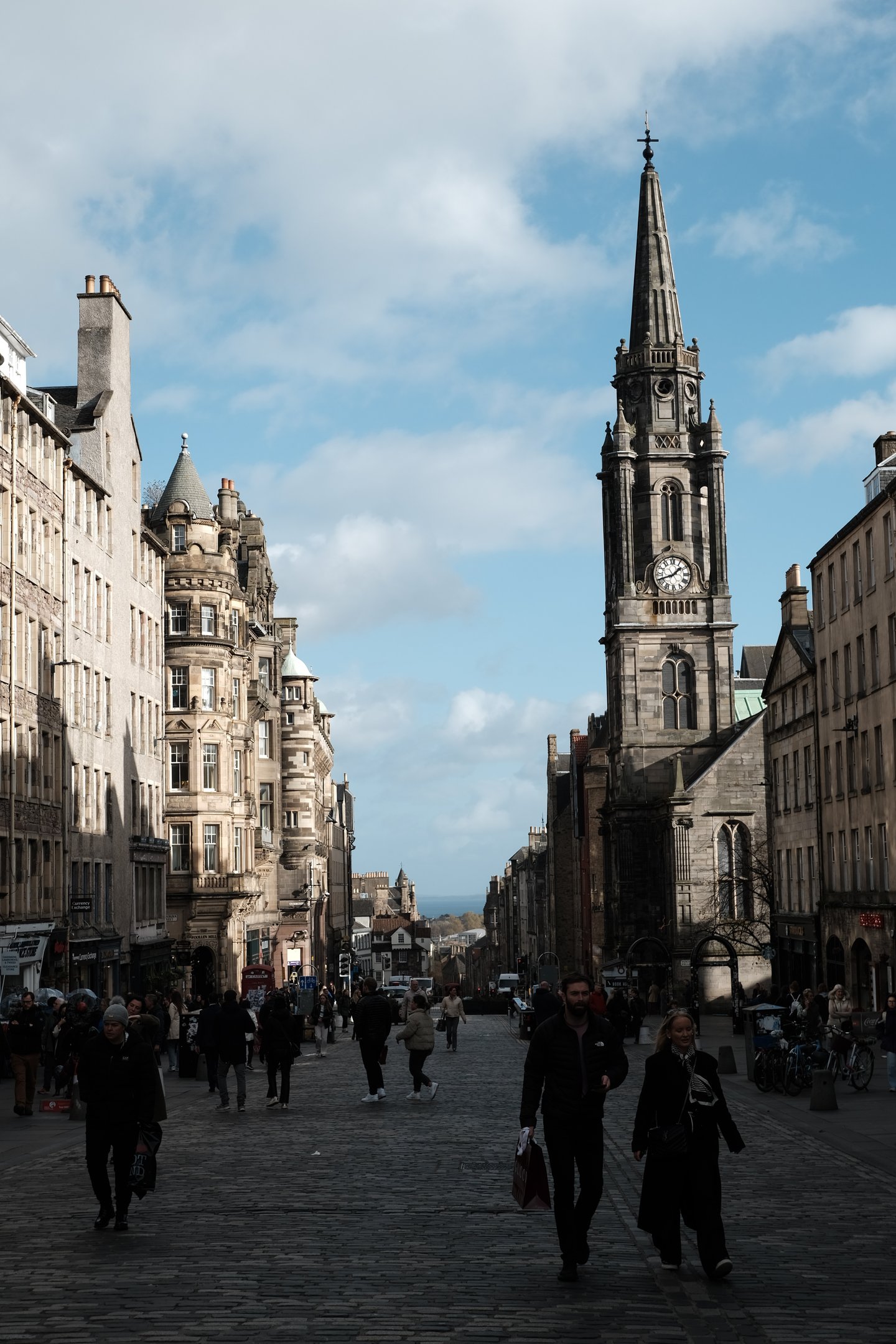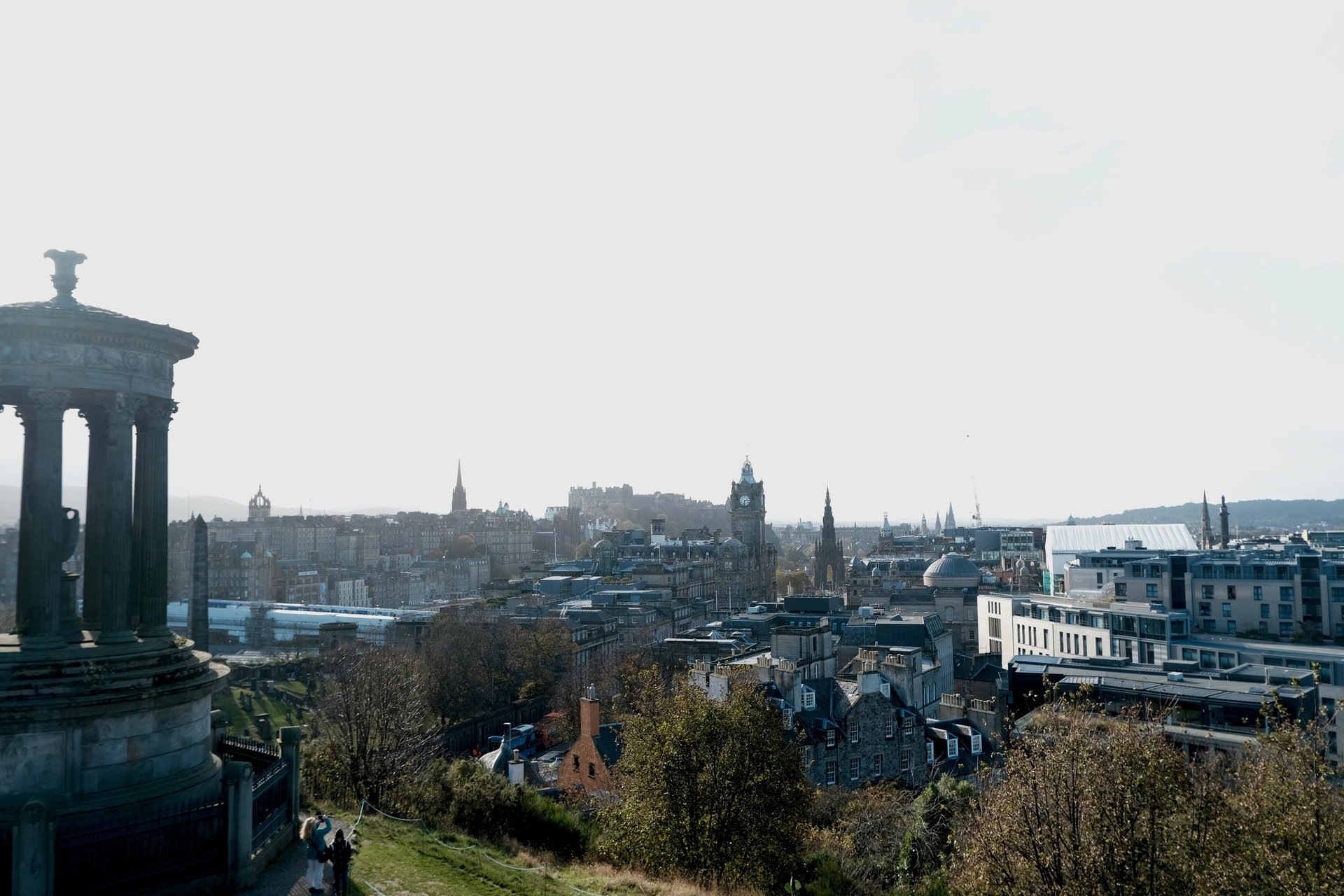
Edinburgh in 26 Hours 8 Minutes
TRIP REPORTSHORT TRIPINTERNATIONAL
Matthew Wietstock
10/28/202526 min read
City Highlights
Location: Edinburgh, Scotland
Population (Metro): 514,990
Known for: Capital of Scotland and seat of the Scottish Crown, the Royal Mile, UNESCO recognized Old and New Towns, centre of Scottish culture and arts
Weather during visit: Partly Cloudy with spotty rain showers, 8 - 13ºC (46 - 55ºF)
Time in Place: 26 hours 8 minutes
The Capital of the Scots, the Athens of the North, Old Smokey, Edinburgh has had many titles to adorn it through the ages since its founding sometime around 600AD, but none can truly sum up the awe and joy that I felt while exploring this fabled city. A centre of Scottish arts and culture for a millennia, the city is a living chronicle of all the nation of Scotland has been through from the pre-medieval roots to a modern economy with every stage along the way visible in the architecture and development the city is coated in. From my first moments in the city, before I had even stepped off the tram for the first time, I knew that Edinburgh would be a fantastic place to explore, to soak in centuries of history, and to experience the Scottish way of life. Its castles, its universities, and even its cafes have a deep sense of enchantment around them, an enchantment that can make the city feel utterly fantastical.
Perhaps it comes as no surprise from just this short introduction that I have developed a severe fondness for Edinburgh, but I think that many who visit will experience similar emotions to what I have. It’s undoubtedly a charming city that does not feel like it has abandoned its roots despite being an economic powerhouse not just for the United Kingdom but for Europe as a whole. The people are friendly, the food is excellent, and there was so much to see and do that even with my jam-packed schedule I had a list of things that I wanted to see but did not have the opportunity to, a list which only grew as the visit went on. I did manage to see many of the city highlights, however, and have many great things to say about those experiences.


Arriving in Edinburgh
Getting to Edinburgh
Edinburgh is a city with many ways to get to it. It is well connected as part of the UK highway system, including the A1 which connects the city directly to London, and the A8 connecting to Glasgow. The highway connections also lend themselves to the various motor coach services available. It is worth noting that Edinburgh has some of the worst traffic congestion not only in Scotland but the UK as a whole. There is also a cruise terminal located in the suburb of Leith used by luxury cruise lines such as Oceania and Seabourn. Ports for larger ships operated by lines like Celebrity and Princess are located further west of the city in South Queensferry or further still (other side of Glasgow on the west coast) in Greenock.
Railways are another incredibly important link for Edinburgh. The primary rail station for the city is Edinburgh Waverley Station, the second busiest by passengers in Scotland behind Glasgow Central. In 2016 the station was the fifth busiest station outside of London in the United Kingdom. Waverley serves as a primary transport hub for the national operator ScotRail, as well as a major stop and semi-terminus for the London North Eastern Railway, the Caledonian Sleeper, and the TransPennine Express. There are also several other important stations in Edinburgh area such as Edinburgh Gateway, Haymarket, and Edinburgh Park, each serving as a terminus point for intercity and commuter rail services.
For international visitors there is Edinburgh Airport, the busiest airport in Scotland and the sixth busiest in the whole United Kingdom. In addition to domestic flights within the British Isles and short-haul international to other European countries, travelers can catch flights to Asia, Africa, and North America. For North American travellers looking to visit, the main three US international carriers and two Canadian carriers provide summer seasonal service to Edinburgh from their east coast hubs (New York-JFK, Philadelphia, Toronto-Pearson, Montreal-Trudeau, ETC.) and United operates year-round service from Washington-Dulles and Newark. Additionally, there are also easy connections for travellers looking to connect through to Edinburgh on budget carriers like easyJet and Ryanair.
Edinburgh Airport is where my travels in Scotland began. The terminal upon arrival is nothing particularly special, fairly spartan in design and industrial feeling. In a sense it did not quite feel finished. It did, however, get the job done, and there are plenty of passenger amenities available. Passport control was quick thanks to the use of automated gates for certain countries like the UK, the EU, the United States, Canada, and Japan. It took me no more than 15 minutes to get through passport control and customs before getting spat out into the arrivals area. Following the signs for ground transportation through the rather crowded and under-construction arrivals hall, I eventually made it to the station for the Edinburgh Trams.
Transportation in Edinburgh is fairly comprehensive, though not as flashy or well-integrated as in other European cities. The main method of transportation around the city is provided by Lothian Buses, a municipal operated owned by a combination of Transport for Edinburgh and several of the surrounding councils. Travelers can either pay by exact change, a Ridacard contactless pass card, or contactless payment using a bankcard or smart device. Ridacards must be purchased in person at a travel shop and include the user’s photo, so this is not usually recommended for short-term visitors. A regular adult fare at the time of publishing is £2.20.
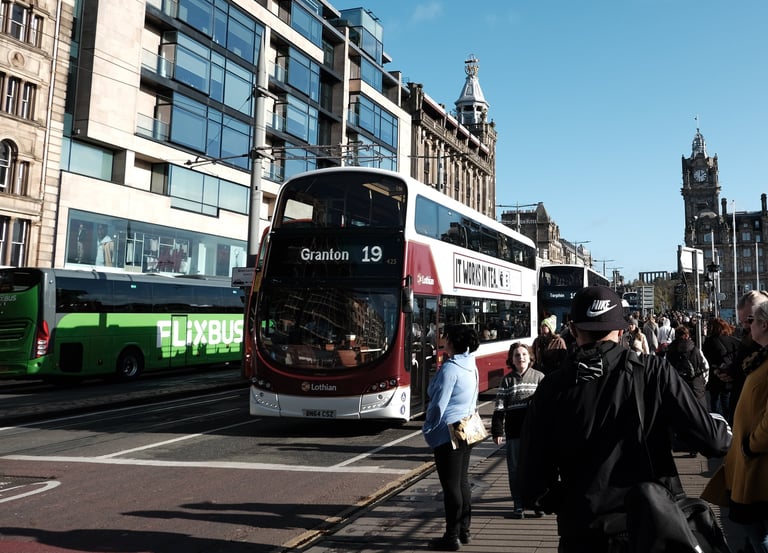

Getting Around Edinburgh
Like most of the major cities in North America and some in Europe, Edinburgh had a sprawling tram network in the early 20th century that was phased out mid-century in favor of buses and personal automobiles. And, similar to the other cities, Edinburgh has since realized the error in their ways of doing that and having since constructed a modern tramway. While the tram is, at the time of writing, a single line, it does a wonderful job connecting different parts of Edinburgh together. The current line stretches 18.5 km (11.5 mi) from the airport to the suburb of Newhaven located along the coast of the Firth of Forth with 26 stops along the way. The project has been subject to considerable criticism, but in the 2023-2024 financial year the tram moved an estimated 10.1 million passengers, a figure roughly comparable to Baltimore’s light rail and rapid transit systems combined for a city that is over 70% larger. This figure is also roughly comparable to about half of the ridership on the London Tramlink system which has an additional 10 km (7 mi) and 13 stations.
When I visited Edinburgh the trams were running with a buy-before proof-of-payment system utilizing kiosks at the various stations. The ticket buying process was pretty easy as one would expect it to be. Since my visit, however, Edinburgh has implemented a contactless “tap-on tap-off” scheme using one’s contactless bank card or smart device which charges a fare based on the beginning and end point like London’s Oyster or Washington DC’s SmarTrip systems. The added benefit of using the tap-on tap-off is that there is daily and weekly fare capping shared between the buses and trams. A standard adult single zone fare at the time of writing is the same as the bus fare, £2.20, but an airport zone ticket is £7.90, a pretty steep price compared to some cities like Chicago, Salt Lake City, or even London (when traveling on-peak between Heathrow and Zone 1).
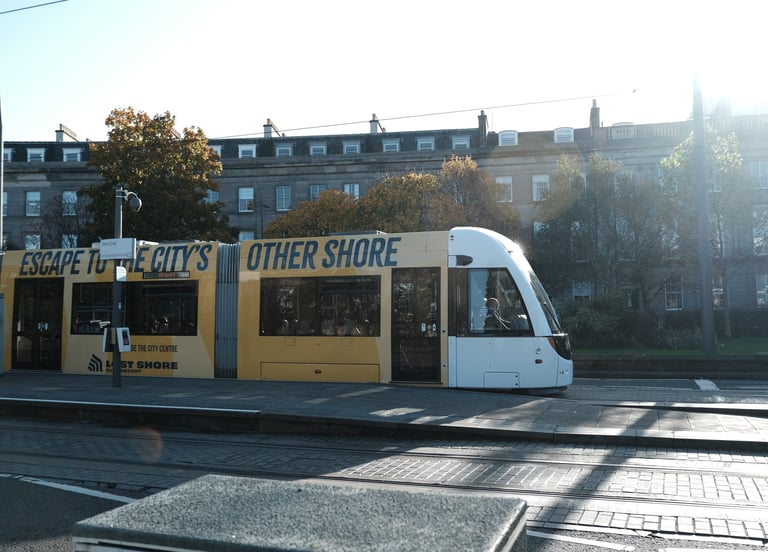

I walked up to the station just as a tram was leaving, meaning I had time to purchase my ticket and get onto the newly arrived tram to avoid sitting in the cold for long. The interiors of the trams were nice, if not unremarkable, which in the world of public transit is a good thing. Considering that the trams act as the main link from the city centre to the airport, it was nice to see luggage racks on each of the trams I boarded. The trams themselves are CAR Urbos 3 low-floor train sets delivered between 2010 and 2012. I did not have long to wait for the tram to begin its journey as the system operates on 7-minute headways during peak period.
Once we were moving it was a nice, smooth ride that got me from point A to point B quickly. Between the airport and the first station of Ingliston Park and Ride (even Edinburgh is not immune to the park and ride phenomena) a fare inspector came by to check and mark tickets, the only time I would see a fare inspector on my journey into town most likely due to the higher airport fare. Once the train reached a few stations past the airport it filled up quickly, especially at stations like Gogarburn and Edinburgh Gateway where there were other transit connections. All of the seats were soon filled and the tram was reaching high levels of standing passengers as we approached the city centre. A little of a half hour after leaving the airport we reached the heart of Edinburgh in New Town with Edinburgh Castle rising above the route to the south. A tip for first time visitors: sit on the right side of the tram in the direction of travel to see this great view of a transit-accessible castle. Hopping off at St. Andrew’s Square, I had finally arrived in Edinburgh.
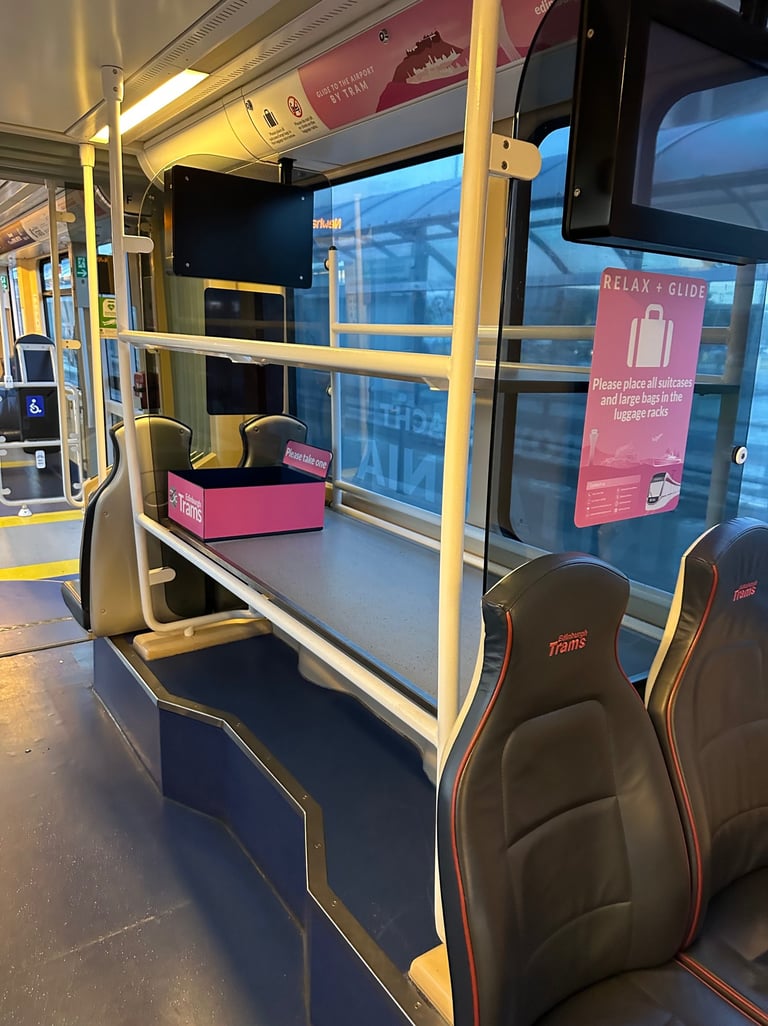

The first thing that I, and many other visitors, noticed on my first visit to Edinburgh is just how hilly the city is. I do not know why I did not expect this (perhaps due to the majority of my time in the UK being spent in fairly flat London, and not having done much research for this trip), but there are few cities I have been too with more varied terrain than this one. Many of the streets and buildings are built into the various ridges and valleys surrounding the castle, so steps will be required. After getting off the tram I made my way south back towards Princes Street and Waverley Bridge. This is the one of the epicentres of Edinburgh’s tourism, with the Scott Monument (notice the two t’s; this is named for the writer Scott not the Scottish people) to my immediate right, Edinburgh Castle behind there, and Waverley Station to my left. Below the bridge is the station’s platforms as well as Prince’s Street Gardens. The Waverley Bridge acts as one of the connection points between New Town and Old Town Edinburgh, with Old Town centreed around the Royal Mile stretching between Holyrood Palace and the Scottish Parliament at the bottom of the hill and the Edinburgh Castle at the top.

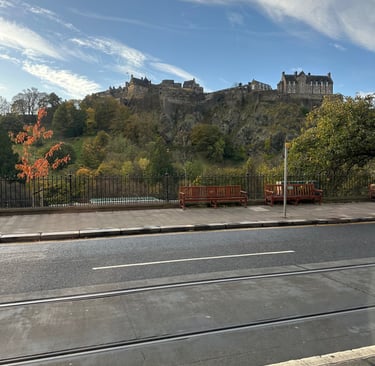

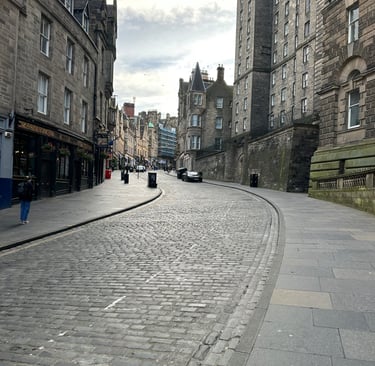
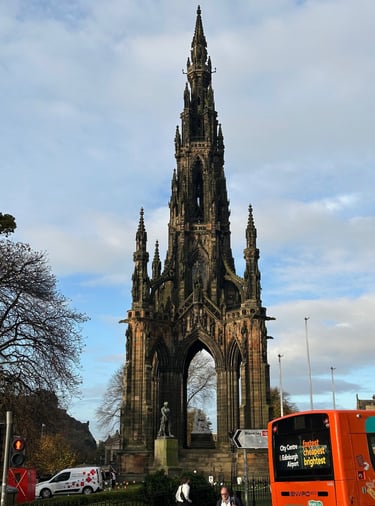

What's New is Old
Once I was in Old Town I was greeted by my first of many hills, walking up the steep Cockburn Street until it met Warriston’s Close which leads up to High Street, the main thoroughfare on the Royal Mile. In Edinburgh there are standard streets of course with motor traffic, but there are also a large variety of closes, courts, and alleys that are pedestrianized either by choice or by being literal staircases; Warriston’s Close is the latter. The heart of Edinburgh is incredibly pedestrianized, but definitely not accessible due to the steep, narrow cobblestone streets. At the top of Warriston’s Close is St. Giles’ Cathedral, the Scottish High Court, and the former jail that is now serving as a hostel, the one where I would be staying that evening. It was too early for me to properly check in, but I was able to leave my backpack in the storage room, freeing me to walk the city with a bit less weight.
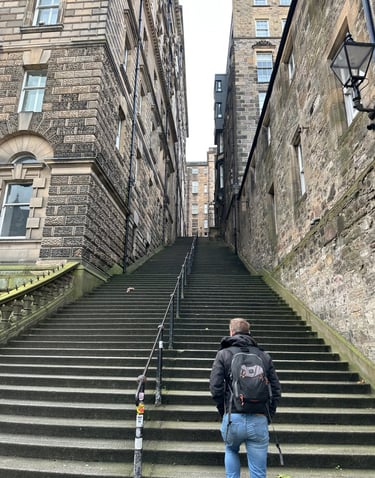

After dropping my bag off I retraced my steps back down Warriston’s Close and Waverley Bridge to New Town and St. Andrew’s Square. New Town is a very good description of the area; it feels a lot newer than the Old Town with wider, less-steep streets more designed for cars. This is also the area where the majority of high-end and fashion brands are located in the city. The buildings are more uniform in design generally speaking, housing more chains of shops and restaurants than local establishments in some cases. The main shopping streets seem to be Victoria and George Streets between St. Andrew’s Square and Charlotte Square. If you are looking for shopping in the area but want something more local in nature, I would recommend the Scottish Design Exchange for a large variety of goods and gifts made by local artists.

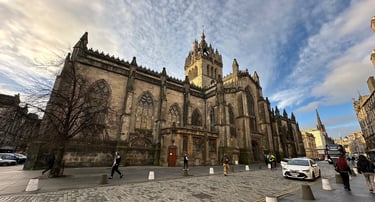
Despite the general uniformity (compared to other areas in Edinburgh), I would not call this area uninteresting. There are assorted statues, squares, parks, and businesses throughout New Town to visit with plenty of plaques to read. I walked along George Street to get a feel for the city, but a couple blocks to the north is Queen Street Gardens, a more linear park that would have allowed me to do the same walk in a less city-like environment. When the east-west running streets met the cross streets, looking to the north offers views down the hill to the Firth of Forth and looking south views of the Old Town and the Castle. Some of the buildings along the way were beginning to sport Christmas decorations as Halloween is not nearly as large of a holiday in Europe as it is in the United States.
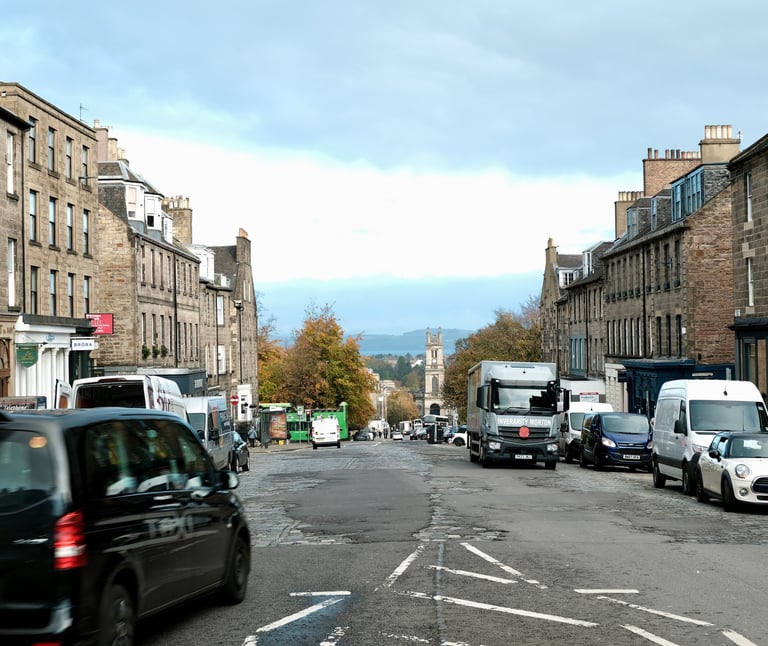

Meandering the full length of the promenade I made it to Charlotte Square, a rather simple city square flanked by historic buildings on all sides. In the centre of the square is a statue of Prince Albert, Prince Consort of Queen Victoria who originally imagined the square as a memorial to her late husband. Directly behind the Prince is the West Register House, formerly a church that now serves as one of the main branches of the National Records of Scotland. This is a pretty common occurrence I found in Edinburgh; there are a lot of churches that have been repurposed into new uses. On the northern end of the square is the Brute House, the official home for the First Minister of Scotland. To the south is Brodie Castle, the Royal Bank of Scotland, and the birthplace of noted telephone inventor Alexander Graham Bell. While I was exploring this area the dark clouds overhead finally carried through on their promise and opened up with a steady drizzle, not a fierce rain but one which could be soaking if left untended to. The change in weather would not discourage my exploring, however, and I pressed onward.

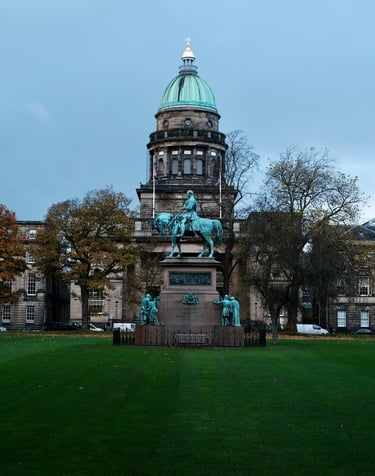
What's Old is Very Old
My wanderings continued to the northwest corner of Charlotte Square towards Glenfinlas Street, then Ainslie Place, and finally Randolph Crescent before I found myself at the threshold to Dean Bridge. Dean Village, located underneath the bridge, is an excellent area for spending some time relaxing and walking around. The village is a medieval milling village, one of the first and closest to the Castle which operated many grain mills along the Leith for centuries. While in the late 19th and early 20th centuries the area was seen as an area of poverty, today it is one of the most desirable locations in Edinburgh. The village is a tranquil spot along the Water of Leith, physically separated from the hustle and bustle of the city with elevation. The Water of Leith Walkway runs from Balerno to the southwest of Edinburgh’s city centre to Dean Village before continuing along to the village of Leith on the banks of the Firth of Forth. While I did not walk much of the 19 km (12 mi) path I have been told that it is a great way to see parts of Edinburgh that are not as often explored.


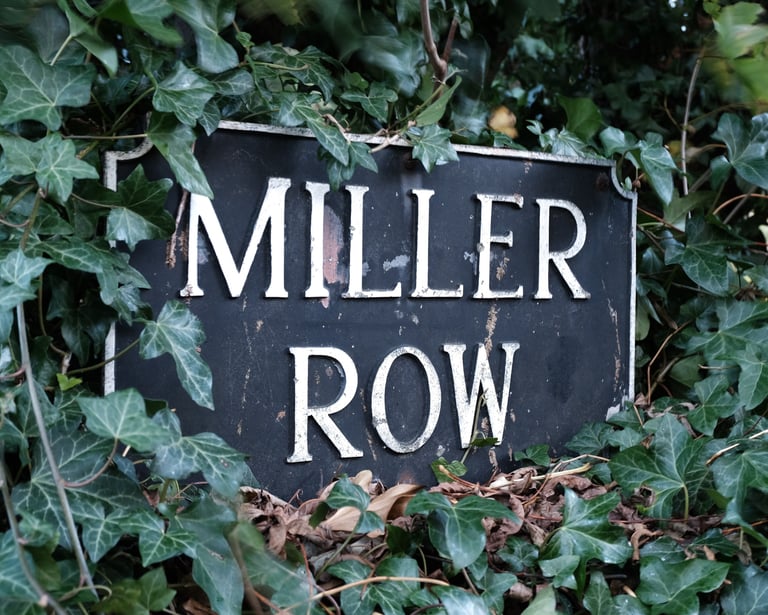

To reach the water from the top of Dean Bridge, walk down Bells Brae, then take a sharp right onto the aptly names Millers Row, one of the most lovely streets I visited while in Scotland. From here you can access the Water of Leith Walkway, along with a small historical monument for the milling industry of Dean and great views looking up at the bridge. Back at the fork of Millers Row and Bells Brae is another bridge across Leith which allows for some of the best photos looking at the historic village along the riverside. Dean Village is older than much of New Town, with varying architectural styles including Tudor (not Tudor revival, actual Tudor) and Elizabethan buildings. Thankfully while I was snapping photos around Dean the sun returned, and would remain out of the rest of the day.
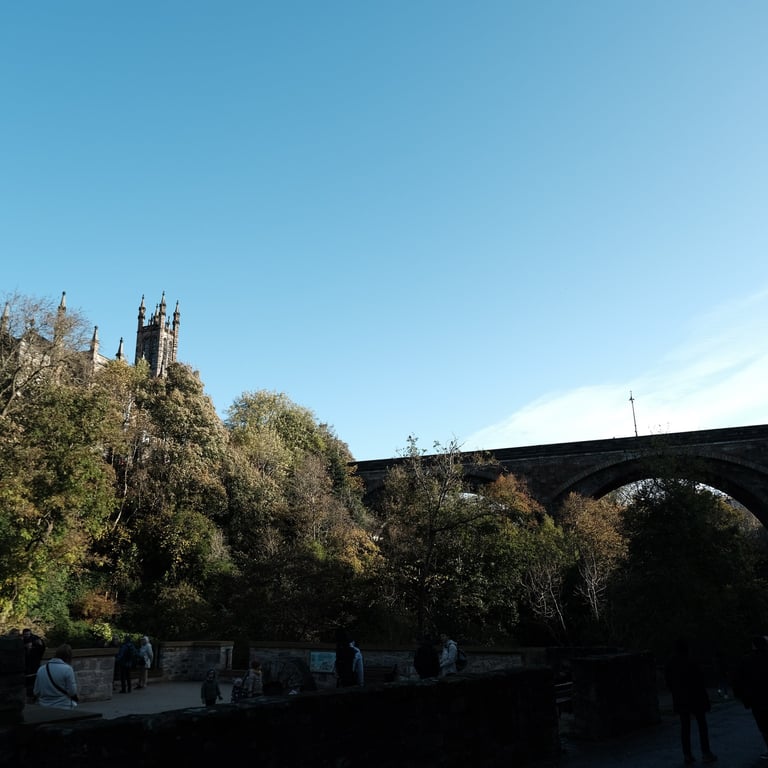
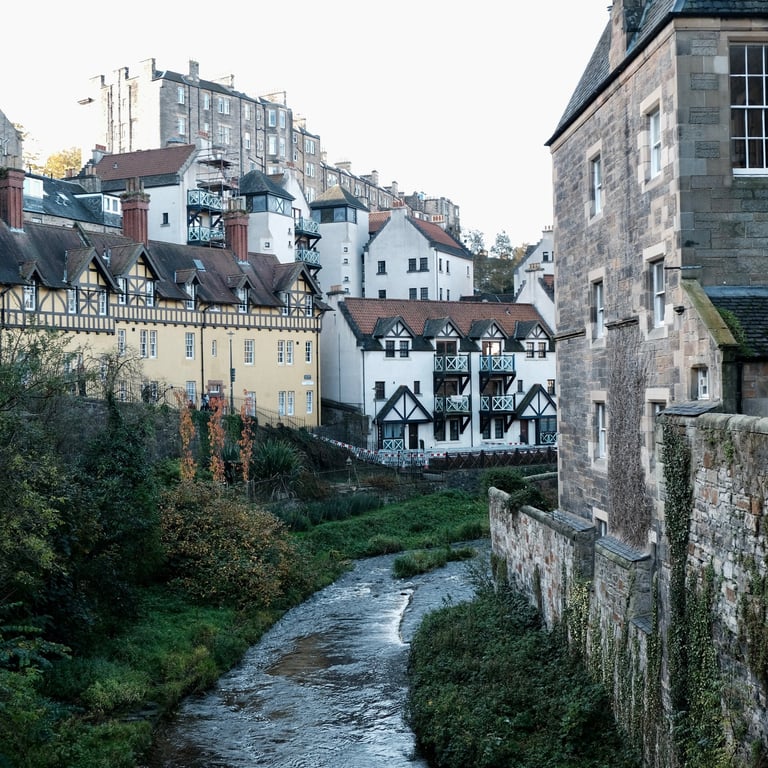
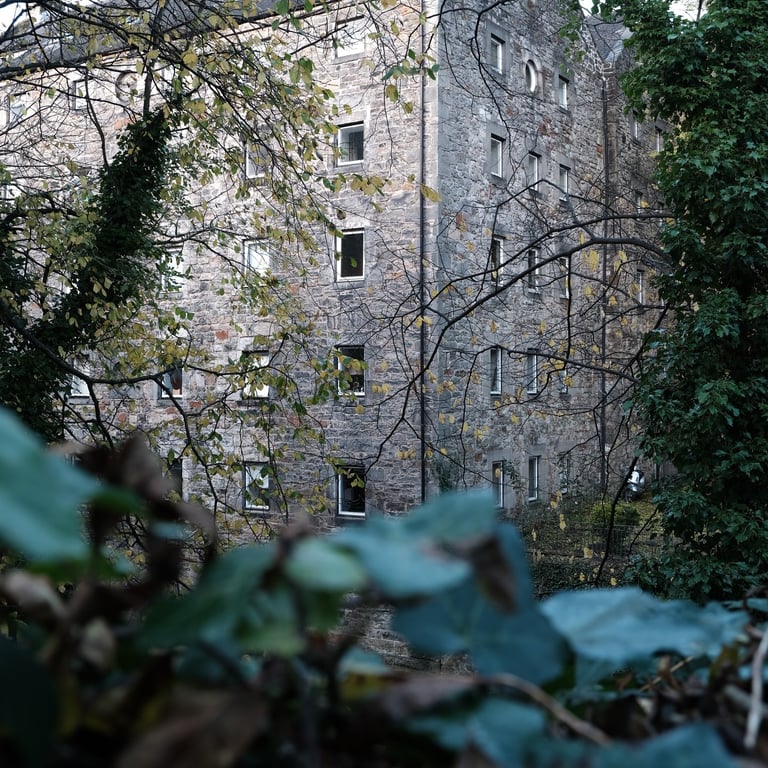
Returning to the top of the bridge I briefly walked across to get aerial views of the village as well as Trinity Church on the northern bank of the Leith. On the south bank, at the intersection of Bells Brae and Dean Bridge is one of the most interesting buildings that I saw while in Scotland, a small residence that looked as if it had been expanded upon in every architectural period along the way since its construction. My best guess is that it was at one point the toll house for the bridge that was completed in the 1830’s, but I have not been able to find any concrete evidence for this. I greatly enjoyed walking around Dean Village, and next time I visit Edinburgh I do plan to walk the length of the Water of Leith Walkway (try saying that ten times fast) to explore more of the area.
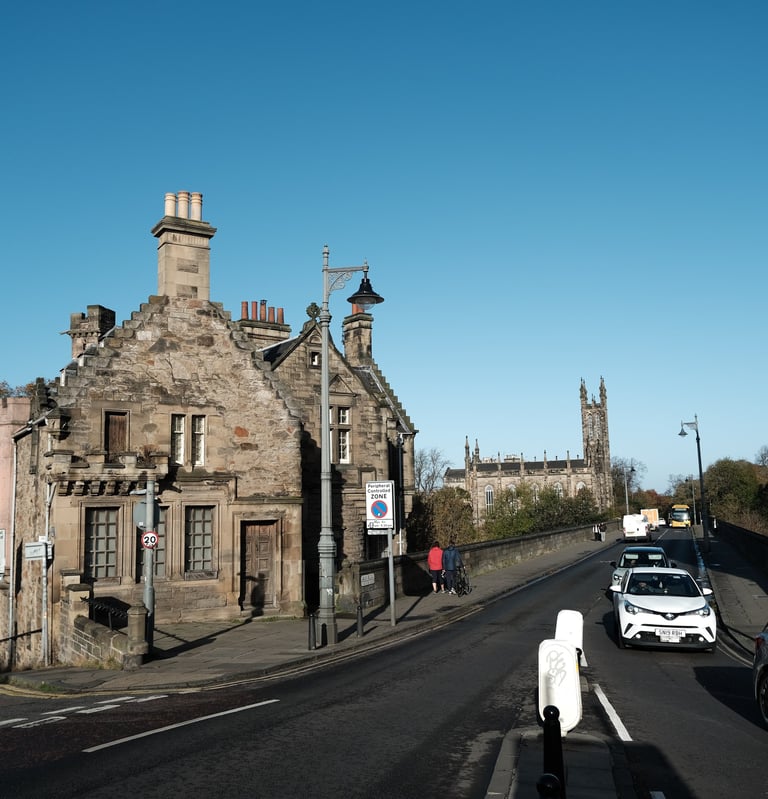

Walking back up from the bridge I moved from New Town to the West End. I continued my walk down Melville Street, which was admittedly under a great deal of construction at the time of my visit. This did lead me to getting a few pictures of the statue of the street’s eponymous Viscount Melville without the base in the shot. At the end of the street is the stunning St. Mary’s Cathedral, the seat of the Bishop of Edinburgh for the Episcopalian Church and one of two cathedrals in Edinburgh to bear the name St. Mary’s (the Catholic cathedral and seat for the Scottish Catholic Church is located on the eastern side of New Town). The Victorian Gothic revival structure is home to the tallest spire in the Edinburgh area, meaning the church is helpful as an orientation point for travellers. The church also houses some of the most beautiful stained glass windows in the area. The rest of the walk back to Prince’s Street was primarily spent along various cobblestone-lined side streets, free from much of the tourist foot traffic on the main roads and quite peacefully lined with local restaurants, though I did make a quick venture to Shandwick Place to try catching another glimpse of the Trams.

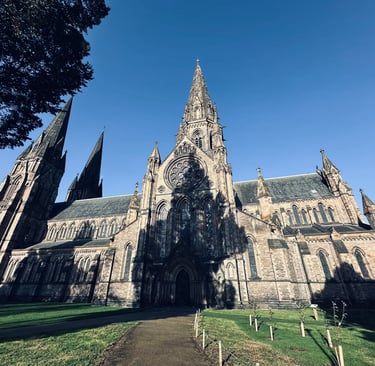
High Street and Higher Street
Back on Prince’s Street the city had ramped up for the day, the sidewalks teeming with other visitors and locals alike. Prince’s Street overlooks the Prince’s Street Gardens, Edinburgh’s main arterial park with the castle rising behind it. It is also home to many of the classic chains and tourist shops that one would expect in the second most visited city in the United Kingdom, behind London with 4 million annual visitors. McDonalds, Taco Bell, Hilton, Ben and Jerry’s, and more chains American and international were plentiful along this stretch. I will admit, however, that I popped in to one of my favorites when visiting the UK, Pret, for a halloumi and falafel wrap plus a pumpkin spice latte; when in Roman autumn.
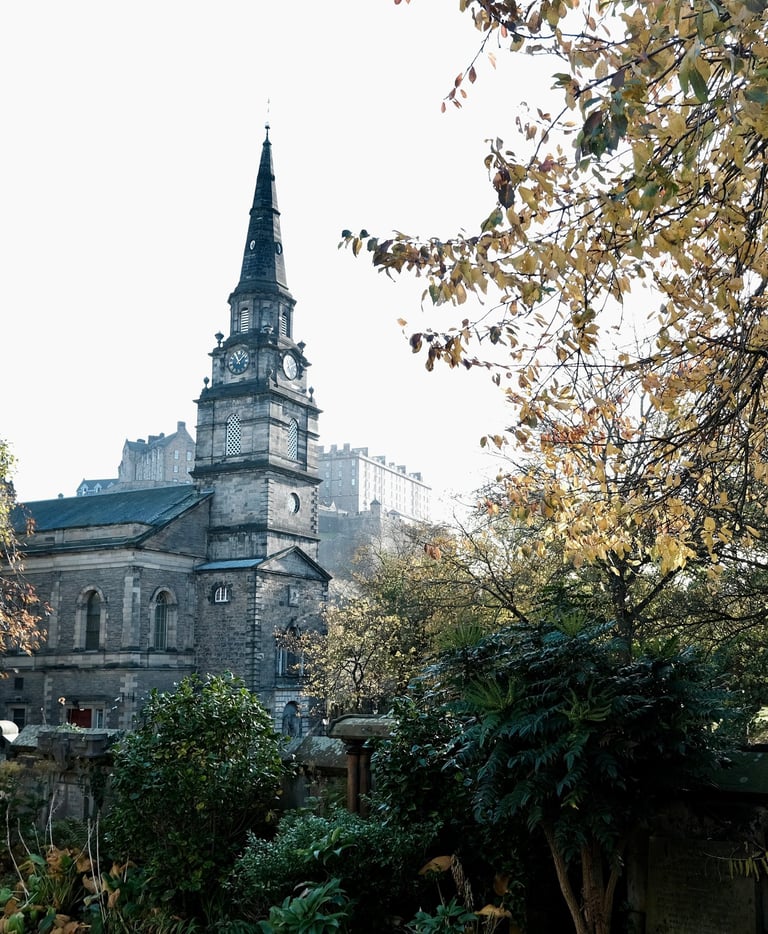

Following this quick lunch I was back out on the streets and down into the gardens themselves. Similarly to Dean Village, Prince’s Street Gardens offers a relaxing area separated from the bustle of the city through an elevation change. I could still hear some traffic, sure, but it was greatly lessened when walking through the wooded St. Cuthbert’s Kirkyard and seeing all the graves that date back twice as old as the country from which I came. Interestingly enough, the first record of the church (or Kirk as I’ve found out that it what they are referred to in Scottish) dates back to 1128, the same as Dean Village when both were ceded to the Holyrood Abbey. This section offers some of the best views of the castle from below, and the gardens as a whole are one of the nicest leisure walks through the city, perfect for enjoying the newly nice day.
There’s lots to see in and around the gardens. There’s the Ross Fountain and Ross Band Stand, and my personal favorite is a memorial dedicated to Wojtek the Soldier Bear. About halfway down the gardens is The Mound, home to the National Galleries of Scotland. The eastern side of the gardens has the previously mentioned Scott Monument, the second largest monument in the world dedicated to an author. It is an impressive and imposing monument, though not as large as one might expect from looking at pictures. There are tours offered to walk up the stairs into the main hall of the monument for £9 at the time of publishing. It is fitting that the monument to Sir Walter Scott sits above Waverley Station, which was named after his first novel and largest success.
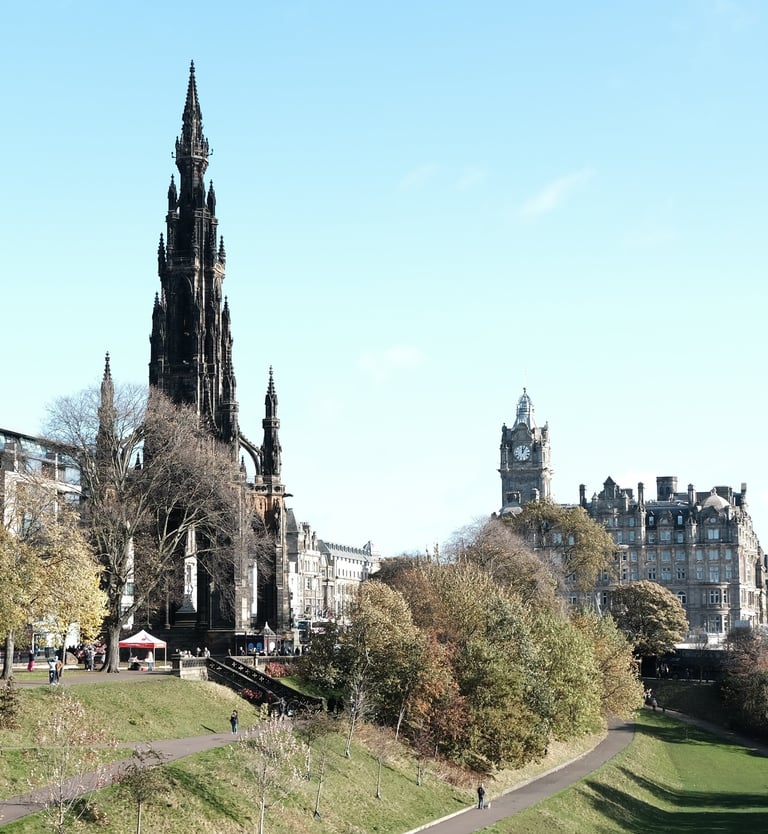

Finishing my exploration of the gardens near the National Gallery, I made my way up the Playfair Steps to reach Edinburgh’s Old Town again. This area is rich with history, Scottish culture, and the money of tourists. Turning right at the top of the steps from Mound Place, I was passing by a seemingly innocuous gate when I noticed a tour group enter and, on a whim, decided to follow them in. I am extremely glad that I did as I was unknowingly following them into my favorite spot in Edinburgh.
New College was constructed in the 1840’s and is “new” for a city that is over 900 years old. Part of the University of Edinburgh system, New College houses the graduate and post-graduate schools for divinity, helping to make sense of how the buildings appear to be divine in origin. University buildings have long caught my interest with their unique yet practical designs (the Geisel Library at UC San Diego is one of my favorites), and I always appreciate a good church, so it only makes sense that I would instantly fall in love with the school for religious studies in a medieval city. Inside the courtyard is a staircase flanked on either side by octagonal towers, and a central spire rising beyond that. It was said that a certain wizard school was modelled after New College, and I can understand fully why as it did feel like a place where magic could happen.
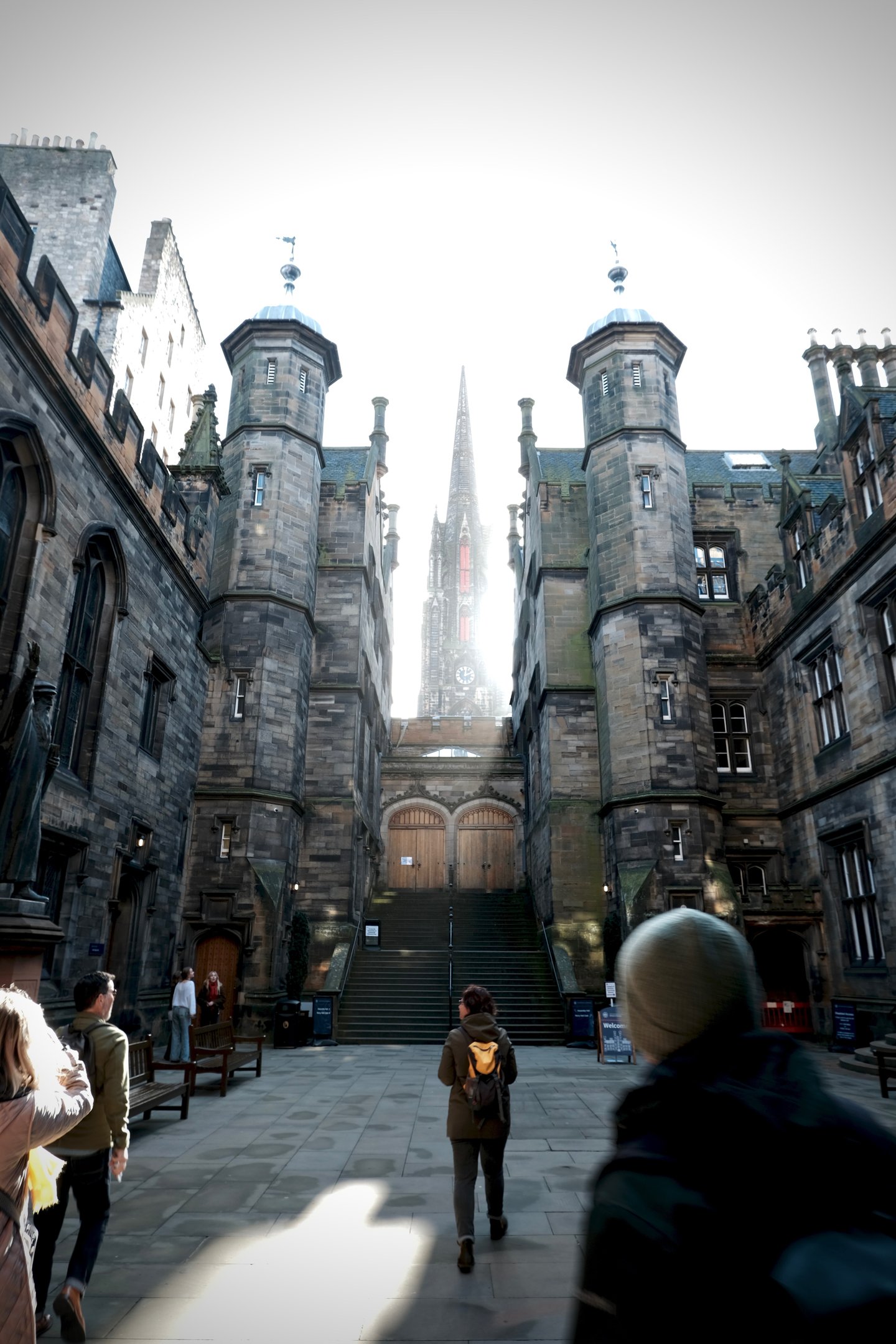

After finally prying myself away from New College I continued up the hill to reach High Street and the Royal Mile. Undoubtedly, this area is at least somewhat overrun with tourists, but I cannot claim to be superior to any of them because here I am writing this. I will say that there were more interesting places that I visited within Edinburgh, even within Old Town, but I can also understand the appeal of the Royal Mile. For starters, there’s Edinburgh Castle. I got actual goosebumps the first time I walked up to the castle just from the sheer weight of the history surrounding it all. I mentioned seeing it from below many times during this report already, and that’s because it is on one of the highest points in the city. Being on the same level as the castle, elevated above the rest of the city streets, it is such a unique and awesome experience that I get kings a little more now. The view from the esplanade in all directions is simply incredible.




The castle is undoubtedly the highlight of the Royal Mile for many visitors, and there was a significant line to enter throughout the day. I did not have the chance to go inside on this trip, but it is something that I will make sure to do next time I go. Tickets often sell out quickly and need to be pre-purchased online for £21.50 at the time of writing. If you are unable or unwilling to to get ticket, there are still plenty of great views to get of the castle from the various points around the city like the ones I have already mentioned.
Walking to the east from the castle down the hill you will pass by many, many tourist focused businesses. This area of Edinburgh was the most crowded with tourists (present company included). There were also some rather nice spots along the way aside from the main draws, such as St. John’s and the George IV Bridge. The George IV Bridge in particular is fascinating as it helps to illustrate just how multi-tiered the city is in construction, with some buildings having entrances at both the base of the bridge and on the bridge’s deck. Also on the bridge is the National Library of Scotland, hosting a splendid collection of literature and documents in a couple of well appointed buildings, and even housing a small gift shop.
South of High Street is another nice area, Grassmarket, Victoria Street, and Greyfriars Kirk and Kirkyard. Grassmarket is a fairly relaxed area with a mix of tourists and local shops around a small green area which leads up the hill to Victoria Street, itself a charming cobblestone street with a nice variety of establishments. One of these is The Elephant House, the supposed location of writing of the first Harry Potter book. Greyfriars is a lovely looking church from the outside (I did not venture into this one) but the Kirkyard that surrounds it is exceedingly peaceful with gratitude views in all directions.

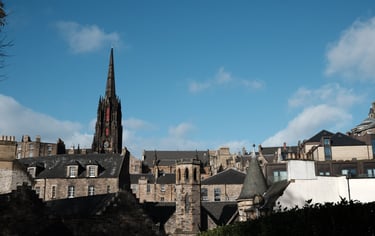

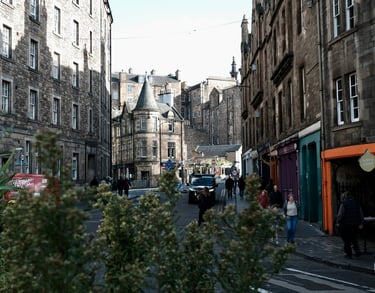
Dinner Break
Heading back to the High Street and continuing east is the Tron Kirk Market. Previously a parish church constructed in the 17th century, today the building houses another location of the Scottish Design Exchange. There is a nice variety of wares at the market from local artisans, and it offers the unique opportunity to view the gorgeous stained glass windows and massive ceiling beams from the inside. Further east still is the John Knox House, supposedly the home of the Protestant reformationist during the 16th century. Today it is a museum and one of the best preserved dwellings from that time period. In front of the house is the Fountain Well, one of the last public cisterns in Edinburgh that was first constructed in 1675. Also located at the John Knox House is the Scottish Storytelling Centre, my next destination thanks to a very particular restaurant.
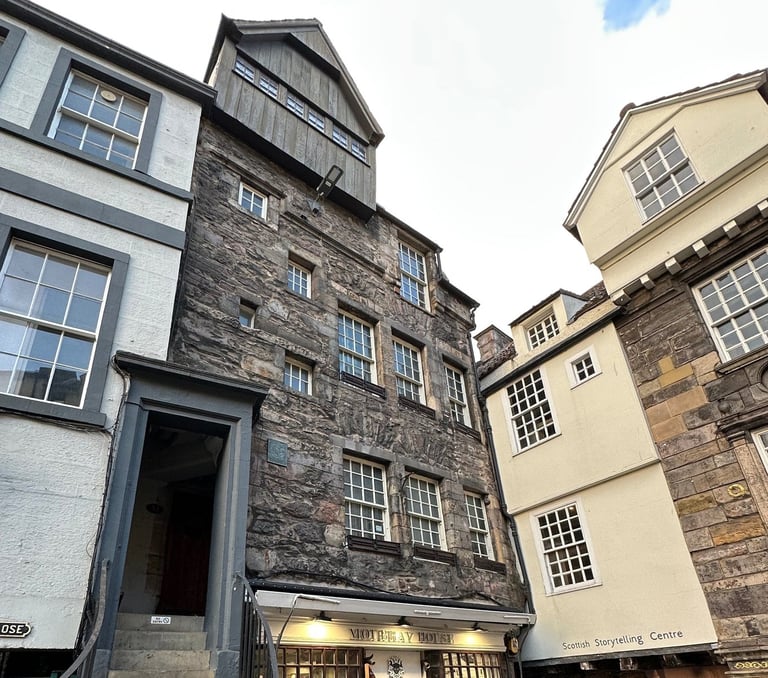

When one thinks of Scottish culture, more specifically cuisine, one most likely things of haggis. There are two variations on this dish. The first is to take the “pluck” (heart, liver, and lungs) from a sheep, mix it with onion, oats, suet, spices, and stock before placing the mix into the stomach to be cooked. The second way is primarily the same except substituting the pluck for mushrooms, beans, and additional grains, creating a vegetarian friendly haggis that has still been served since the 1800’s. I opted for the later, but I was still quite nervous to try it. I was recommended The Haggis Box by a local and the restaurant staff was incredibly friendly and patient in explaining the various options available to me. After ordering and waiting, it arrived on a plate with neeps and taties (mashed rutabaga and potato) and covered in a mustard whiskey cream sauce. I cautiously took my first bite, chewed for a moment, paused to consider the flavour and the texture, and was incredibly pleased. It is great. Savoury, slightly nutty, complemented perfectly by the veggies and sauce, a good and hearty meal perfect after a day full of climbing staircase after staircase. If you visit Scotland, I would 100% recommend getting haggis, at least in veggie haggis, as it is both delectable and a bit of a bragging right to tell your friends after the fact.


Highland Summit
Full from my delicious meal, I would have been content to just sit on a street corner for the rest of the evening, watching the ancient city bustle with modern life, but there were a couple more things on my to-do list, and one of them had a time limit. When visiting Edinburgh, the most outdoor inclined will want to schedule time to hike up Arthur’s Seat, the highest point in the hills that make up Edinburgh. The summit is renowned for its views overlooking the city, the Firth of Forth, and the rest of the surrounding Scottish countryside. The trail can be rather steep at times, with one of the most common routes from the east rising 270 m (885 ft) over 4.2 km (2.6 mi) for an average 6% grade. Most of the travel sites I’ve seen mentioning climbing Arthur’s Seat recommended on average between two and four hours, which is time that I did not have during this short trip. Instead I oped for the shorter but perhaps more historically significant Calton Hill.
Calton Hill is located about 0.8 km (0.5 mi) north of Holyrood Park where Arthur’s Seat lies. Instead of a simple trail to reach the summit there are a series of steps up the steep hillside. It did not take me long to climb to the top, but once I was up there it was rather flat to walk around and admire it all. While the views may not have as high of a vantage point as Arthur’s Seat, they make up for it by being closer to the centre of town and being the location of several monuments.


In the centre of the plateau on top is a series of structures like the City Observatory, the Observatory House, and the Playfair Monument dedicated to mathematician John Playfair (designed by his nephew, who designed much of the rest of the park William Henry Playfair). To the west of this compound is the Dugald Stewart Monument (noted mathematics-hater) where may of the photos used to promote the city are taken as the monument can be aligned with Waverley Station and Edinburgh Castle behind it. On the southern end of the upper level is the Nelson Monument, a lighthouse-like tower commemorating Vice Admiral Horatio Nelson’s victory (and death) in the Battle of Trafalgar during the Napoleonic Wars. Visitors who have been to London will note this is the same Nelson who has a column in Trafalgar Square there. Another tribute to the Napoleonic Wars sits on the eastern side of the hill in the National Monument, dedicated to the Scottish soldiers and sailors who died during the conflicts. The monument was based upon the Parthenon, but was never completed as funds ran out in 1829, just three years after construction began. There are also, of course, plenty of benches located around the perimeter of the hill to look down upon the Scottish Parliament, Leith, Princes Street, and the whole of Edinburgh.
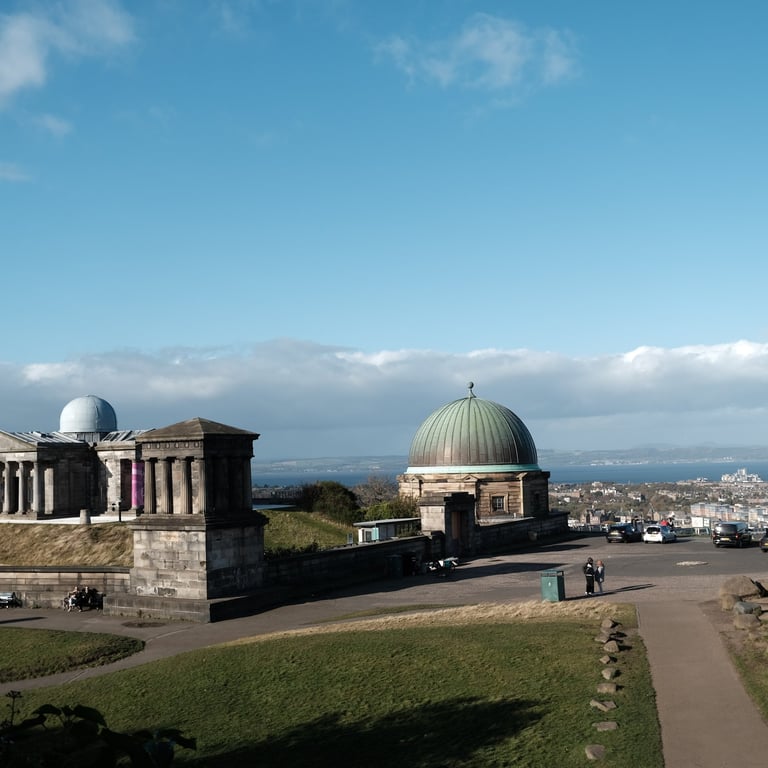
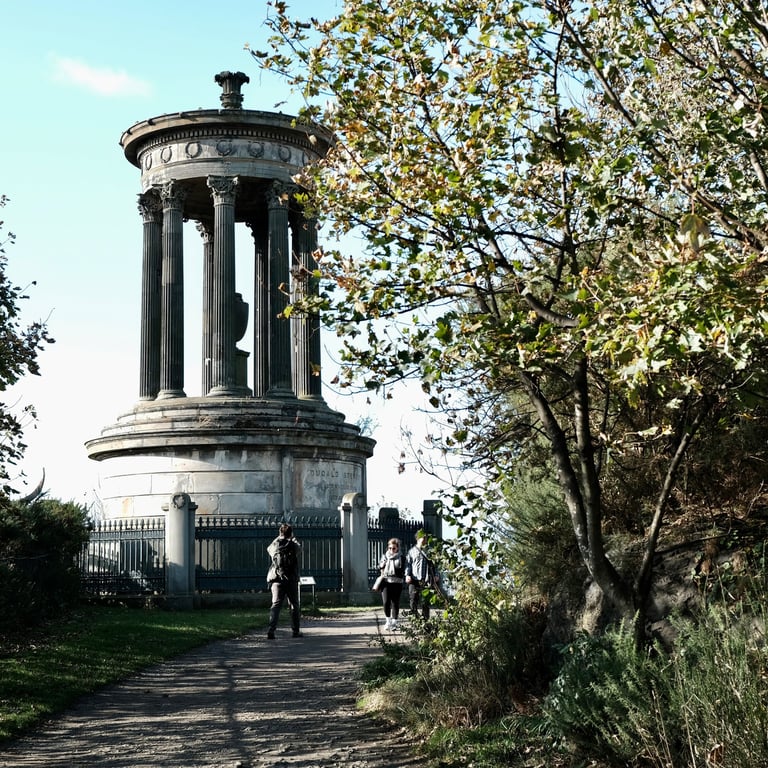
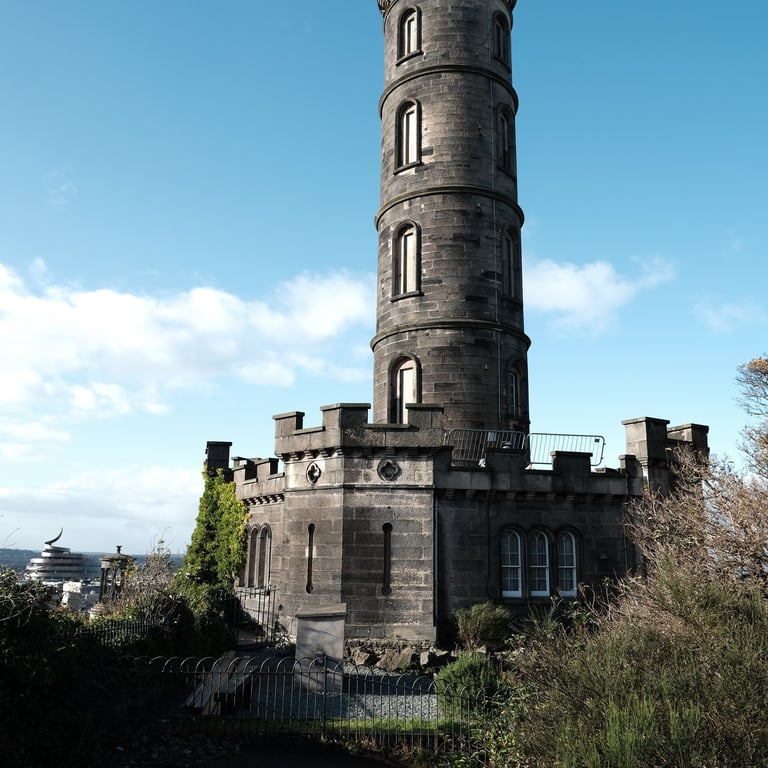
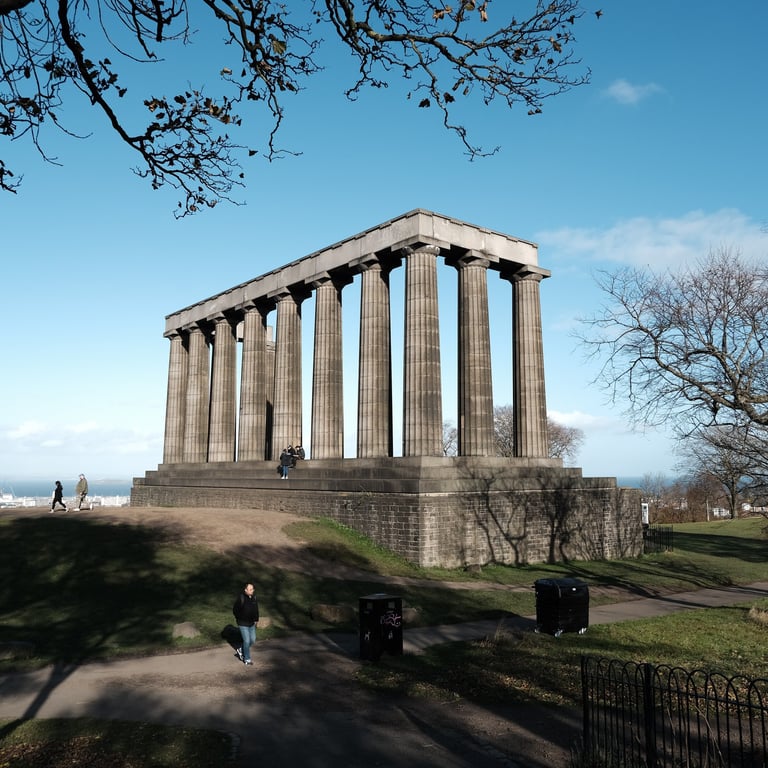

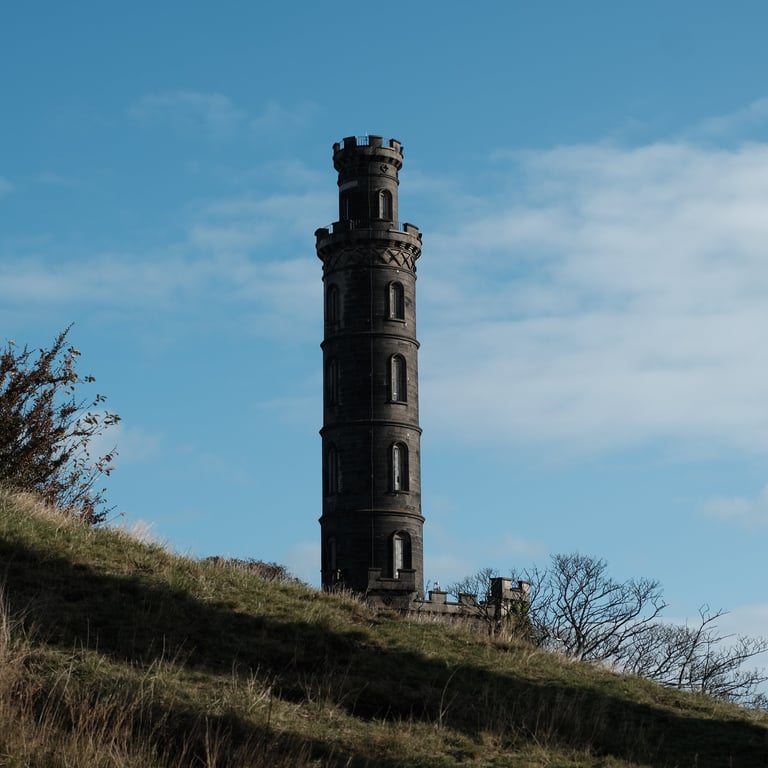
Having rather enjoyed my walk up Calton Hill I decided it was time to visit another recommended spot and, in my opinion, one of the best pubs in Edinburgh. The Guildford Arms is an extremely traditional ubiquitous dating back to Victorian times and located just a block off Princes Street. Upon entering you notice how it seems to step into a time gone by with the leaded windows, gilded fixtures, traditional taps, and well-dressed barkeepers able to expertly identify what you should have to drink based on your preferences. They recommended to me a locally made cider called Thistle Cross, a nice sweet cider that was perfect for relaxing after the long day of walking I had. There were plenty of people in having a pint after work, discussing their own politics or philosophies, or simply enjoying the time by themselves. I spent about an hour there just enjoying the atmosphere while I nursed my pint and wrote the majority of my outline for this report.
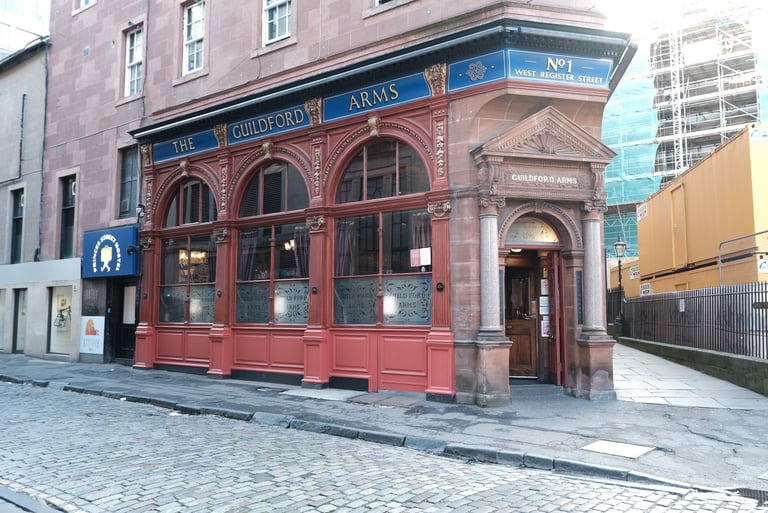

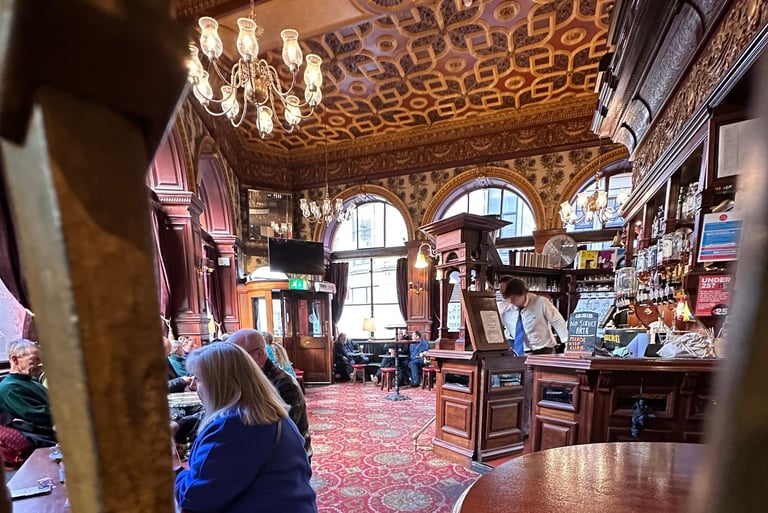

As I finished my cider I strolled back into the crisp yet not chilly air of the October evening. Not content to be finished just yet, I started walking south. Eventually I reached the area primarily dominated by the University of Edinburgh. Students and faculty were out and about in full force, making the most of a nice autumnal evening. I popped into a few different shops along the way and found them to be filled not with tourists but locals looking for a good book or stationary. I rounded the National Museum of Scotland, passed by the statue of Greyfriars Bobby, and followed Candlemaker Row back to Grassmarket where I was able to pick up a few last minute postcards.
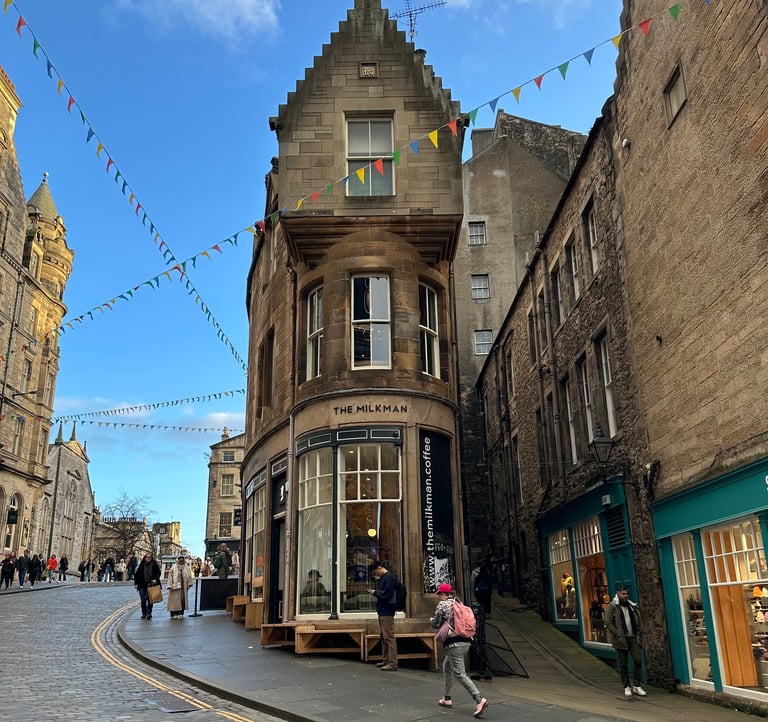

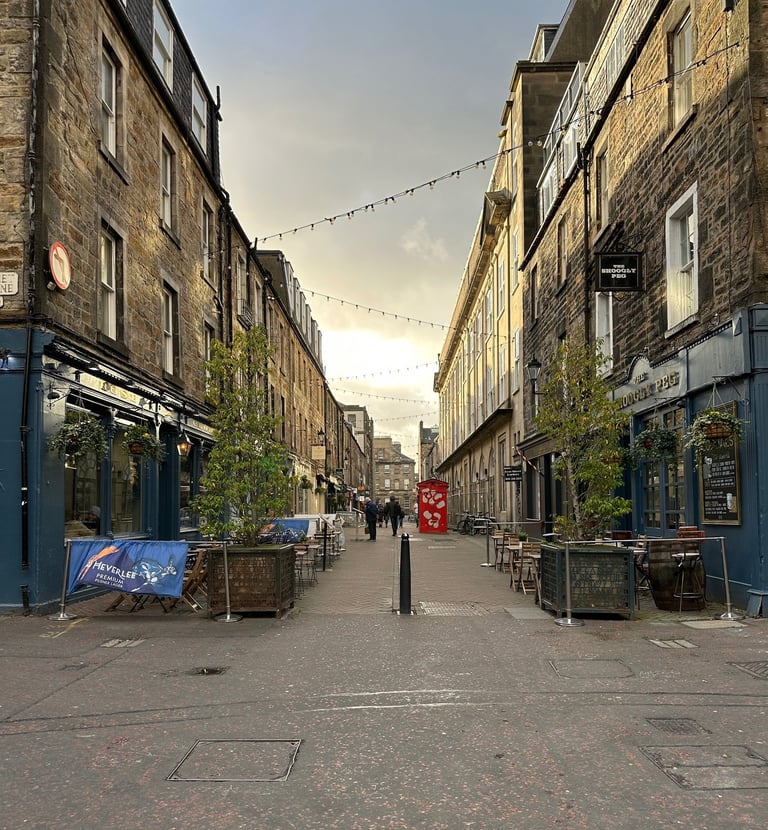

I was exhausted by this point in the evening as I spent the better part of the past 12 hours walking around an incredibly hilly city. I decided I would finish my day off by stopping by the castle one last time to see it properly illuminated. Rounding out my step count for the day I took Castle Wynd, a series of staircases back to the Esplanade, where I found the place nearly deserted. Once the gates of the castle shut most of the tourists go elsewhere, but this meant I had excellent and unobstructed views of the castle. I was also able to get some lovely views of the rest of the city starting to dot their own lights against the impending black stretching over the Firth. By far this was my favorite time of day to visit, and although most of the pictures I took did not turn out well due to making a mistake with the shutter speed on my camera (this was my first major trip with this camera which has since become a staple in my trip reporting), I did manage to get a few nice ones.
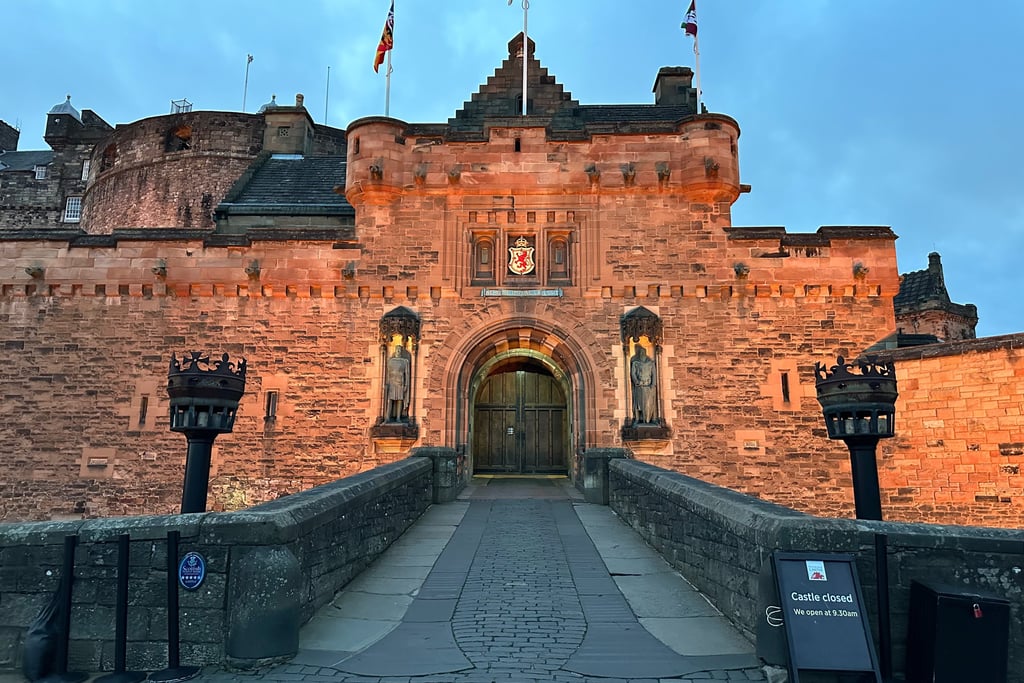

Finishing my photography, I was absolutely done, tapped out, and ready for some rest. Thankfully my hostel was 5 minutes away, and better it was downhill, so I was back to where I had started my time in Edinburgh hours earlier. For this trip I stayed at CoDE, a “pod hostel” which features a series of Japanese-inspired sleeping pods that have a large mattress, an individual reading light, socket, and a locker across from the bed for storing personal belongings. My shared 8-person room for the evening was £56, expensive for a hostel definitely, but still a lot cheaper than many of the surrounding hotels and having one of the best locations in the city before evening mentioning I purchased it as a walkup. I took perhaps the longest shower of my life, set my watch’s vibration alarm for the morning, and passed out completely.

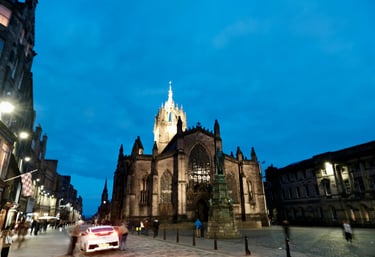
Leaving Edinburgh
Waking up way too early for the amount of tiredness I had left in me given the previous days antics, I quickly gathered my belongings and checked out of the hostel. Following St. Giles Street to the Mound and passing the dark National Gallery, I was struck just how quiet the city was, even for 6 am. All of the museums, tourist shops, and restaurants were obviously shuttered, but it was for the most part deserted on the streets, with only a couple passing cyclists commuting in or a few delivery people making their rounds. As I crossed the Mount I made one last look back towards Edinburgh Castle, enjoying the sight of it lit against the deeply indigo morning sky. I made ti to Prince’s Street stop on the Trams just as one was leaving, but I needed to purchase a ticket so I waited for the next one to arrive. This is where 10 minute off peak headways really show you how cool it can get at 8 C when all you have is a light sweater and a rain jacket.
The tram arrived and was mercifully heated, allowing me to relax. Perhaps too much as I admittedly dozed a bit in the middle. Winding our way to the airport, the ticket inspector made their rounds on the stretch between Ingliston Park and Ride and the airport. Check in and security were fairly common for a European airport, though the security line did take about 40 minutes to complete from start to finish. A not for any Americans travelling through Edinburgh or most other European airports at this point, there is no traditional ID check rather automated gates to scan your ticket. You also will probably not need to remove your shoes or belt unless directly asked by the staff. Post security was fine, nothing major to note really as it was much the same heading out as it was coming in, just with a few more shops open this time. Coffee in hand, I waited for my flight as the sun rose over the Scottish countryside. The clouds hung low, threatening to give way to drizzle again while letting the rays filter through the morning mist.
If it was not obvious by this point, I love Edinburgh. I adored my time there. There are times in the nature of my writing where a single day feels like enough time to get a grasp on all that a city has to offer, to a experience a “well I guess that’s it” moment. This is not one of them. I could have spent a week in Edinburgh and still found new and interesting this to see and do, let alone in the small towns and countryside surrounding. The point of these quick trips is not to try to see everything in a city, rather to see as much of a city as possible so I know what I like and what I do not. It is to find the areas I like travelling to so I can return and enjoy it more. If I see everything in a city in a day, especially in a short day, it means it’s a boring city and I will probably not be back again soon if at all. With what I saw of Edinburgh, I will be racing back. The amount of history present around every corner, the lovely views looking down the hillsides or up from the valleys, the welcoming culture and people all combining together was perhaps one of the most memorable 26 hours I have spent while travelling. If you are interested in seeing a city not just living in its history but living alongside it, while developing newness from it at the same time, visit Edinburgh, I know I will be back again.
